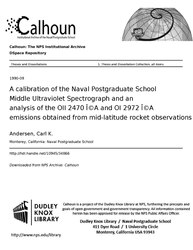File:FEDLINK - United States Federal Collection (IA acalibrationofna1094534866).pdf

Original file (1,275 × 1,650 pixels, file size: 3.41 MB, MIME type: application/pdf, 120 pages)
Captions
Captions
Summary[edit]
| A calibration of the Naval Postgraduate School Middle Ultraviolet Spectrograph and an analysis of the OII 2470 ΩA and OI 2972 ΩA emissions obtained from mid-latitude rocket observations
( |
||
|---|---|---|
| Author |
Andersen, Carl K. |
|
| Title |
A calibration of the Naval Postgraduate School Middle Ultraviolet Spectrograph and an analysis of the OII 2470 ΩA and OI 2972 ΩA emissions obtained from mid-latitude rocket observations |
|
| Publisher |
Monterey, California: Naval Postgraduate School |
|
| Description |
The MUSTANG instrument was calibrated using standard techniques to determine the sensitivity and wavelength calibrations and field of view. The instrument was launched aboard a NASA sounding rocket on March 30, 1990. Post- flight tests indicated that the calibration did not change as a result of the rocket experiment. Ultraviolet dayglow spectra of the Earth's ionosphere were obtained from approximately 100 km to 320 km in altitude over a wavelength range of 1800 A to 3400 A. The spectra were divided into 512 pixels of approximately 3.134 A per pixel. Analyses of the data from 2420 A to 2490 A and from 2920 A to 2972 A were conducted to obtain the intensity profiles of the OII 2470.4 A multiplet and the OI 2972.3 A line emission, respectively. The intensity profile of the OII 2470.4 A multiplet was found to have a broad peak of 1.6 kR centered at approximately 250 km. The intensity profile of the OI 2972.3 A line emission shows a general trend of decreasing intensity with altitude. The maximum intensity of 3.6 kR was found at 105 km and the minimum of 137 R at 315 km. A partial layer, with an intensity of 4.1 kR, was evident near 150 km. Subjects: Ebert-Fastie Spectrograph; ultraviolet spectra; dayglow; OII 2770 ΩA multiplet; OI 2972 ΩA line emission |
|
| Language | English | |
| Publication date |
September 1990 publication_date QS:P577,+1990-09-00T00:00:00Z/10 |
|
| Current location |
IA Collections: navalpostgraduateschoollibrary; fedlink |
|
| Accession number |
acalibrationofna1094534866 |
|
| Source | ||
| Permission (Reusing this file) |
This publication is a work of the U.S. Government as defined in Title 17, United States Code, Section 101. As such, it is in the public domain, and under the provisions of Title 17, United States Code, Section 105, may not be copyrighted. | |
Licensing[edit]
| Public domainPublic domainfalsefalse |
This work is in the public domain in the United States because it is a work prepared by an officer or employee of the United States Government as part of that person’s official duties under the terms of Title 17, Chapter 1, Section 105 of the US Code.
Note: This only applies to original works of the Federal Government and not to the work of any individual U.S. state, territory, commonwealth, county, municipality, or any other subdivision. This template also does not apply to postage stamp designs published by the United States Postal Service since 1978. (See § 313.6(C)(1) of Compendium of U.S. Copyright Office Practices). It also does not apply to certain US coins; see The US Mint Terms of Use.
|
 | |
| This file has been identified as being free of known restrictions under copyright law, including all related and neighboring rights. | ||
https://creativecommons.org/publicdomain/mark/1.0/PDMCreative Commons Public Domain Mark 1.0falsefalse
File history
Click on a date/time to view the file as it appeared at that time.
| Date/Time | Thumbnail | Dimensions | User | Comment | |
|---|---|---|---|---|---|
| current | 06:40, 8 July 2020 |  | 1,275 × 1,650, 120 pages (3.41 MB) | Fæ (talk | contribs) | FEDLINK - United States Federal Collection acalibrationofna1094534866 (User talk:Fæ/IA books#Fork8) (batch 1990-1992 #2778) |
You cannot overwrite this file.
File usage on Commons
The following page uses this file:
Metadata
This file contains additional information such as Exif metadata which may have been added by the digital camera, scanner, or software program used to create or digitize it. If the file has been modified from its original state, some details such as the timestamp may not fully reflect those of the original file. The timestamp is only as accurate as the clock in the camera, and it may be completely wrong.
| Short title | A calibration of the Naval Postgraduate School Middle Ultraviolet Spectrograph and an analysis of the OII 2470 ΩA and OI 2972 ΩA emissions obtained from mid-latitude rocket observations |
|---|---|
| Author | Andersen, Carl K. |
| Software used | Andersen, Carl K. |
| Conversion program | |
| Encrypted | no |
| Page size |
|
| Version of PDF format | 1.4 |

